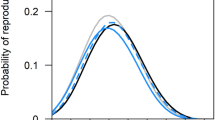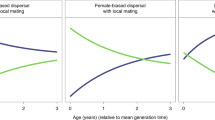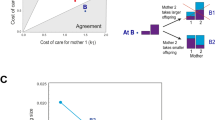Abstract
Helpers in primitively eusocial and cooperatively breeding animal societies forfeit their own reproduction to rear the offspring of a queen or breeding pair, but may eventually attain breeding status themselves. Kin selection1 provides a widely accepted theoretical framework for understanding these societies, but differences in genetic relatedness do not explain a universal societal feature: the huge variation between individuals in helping effort2,3,4,5,6,7,8,9,10. An alternative explanation for this variation lies in a fundamental trade-off faced by helpers: by working harder, they increase the indirect component of their fitness, but simultaneously decrease their own future survival and fecundity2,4,8. Here, we show that individuals work less hard when they stand to lose more future fitness through working. We experimentally manipulated two components of future fitness in social queues of hover wasps (Stenogastrinae): a helper's chance of inheriting an egg-laying position, and the workforce available to rear her offspring should she inherit. After each manipulation, helpers increased or decreased their effort as appropriate to the change in expected future fitness that they experienced. Although helping provides significant indirect fitness benefits for hover wasps11, our study shows that variation in the costs associated with helping is the major determinant of helping effort.
This is a preview of subscription content, access via your institution
Access options
Subscribe to this journal
Receive 51 print issues and online access
$199.00 per year
only $3.90 per issue
Buy this article
- Purchase on Springer Link
- Instant access to full article PDF
Prices may be subject to local taxes which are calculated during checkout



Similar content being viewed by others
References
Hamilton, W. D. The genetical evolution of social behaviour. I and II. J. Theor. Biol. 7, 1–52 (1964)
Heinsohn, R. & Legge, S. The cost of helping. Trends Ecol. Evol. 14, 53–57 (1999)
Clutton-Brock, T. H. et al. Individual contributions to babysitting in a cooperative mongoose, Suricata suricatta. Proc. R. Soc. Lond. B 267, 301–305 (2000)
Cant, M. A. & Field, J. Helping effort and future fitness in cooperative animal societies. Proc. R. Soc. Lond. B 268, 1959–1964 (2001)
Griffin, A. S. & West, S. A. Kin discrimination and the benefits of helping in cooperatively breeding vertebrates. Science 302, 634–636 (2003)
Keller, L. Indiscriminate altruism: unduly nice parents and siblings. Trends Ecol. Evol. 12, 99–103 (1997)
Queller, D. C. et al. Unrelated helpers in a social insect. Nature 405, 784–787 (2000)
Cant, M. A. & Field, J. Helping effort in a dominance hierarchy. Behav. Ecol. 16, 708–715 (2005)
Clutton-Brock, T. H. Breeding together: kin selection and mutualism in cooperative vertebrates. Science 296, 69–72 (2002)
Griffin, A. S. & West, S. A. Kin selection: fact and fiction. Trends Ecol. Evol. 17, 15–21 (2002)
Field, J., Shreeves, G., Sumner, S. & Casiraghi, M. Insurance-based advantage to helpers in a tropical hover wasp. Nature 404, 869–871 (2000)
Sundstrom, L., Chapuisat, M. & Keller, L. Conditional manipulation of sex ratios by ant workers: a test of kin selection theory. Science 274, 993–995 (1996)
Stiver, K. A., Dierkes, P., Taborsky, M., Gibbs, H. L. & Balshine, S. Relatedness and helping in fish: examining the theoretical predictions. Proc. R. Soc. Lond. B 272, 1593–1599 (2005)
Heinsohn, R. & Cockburn, A. Helping is costly to young birds in cooperatively breeding white-winged choughs. Proc. R. Soc. Lond. B 256, 293–298 (1994)
West-Eberhard, M. J. in Natural Selection and Social Behaviour: Recent Research and New Theory (eds Alexander, R. D. & Tinkle, D. W.) 3–17 (Chiron Press, New York, 1981)
Shreeves, G. & Field, J. Group size and direct fitness in social queues. Am. Nat. 159, 81–95 (2002)
Kokko, H. & Johnstone, R. A. Social queuing in animal societies: a dynamic model of reproductive skew. Proc. R. Soc. Lond. B 266, 571–578 (1999)
Field, J., Shreeves, G. & Sumner, S. Group size, queuing and helping decisions in facultatively eusocial hover wasps. Behav. Ecol. Sociobiol. 45, 378–385 (1999)
Sumner, S., Casiraghi, M., Foster, W. & Field, J. High reproductive skew in tropical hover wasps. Proc. R. Soc. Lond. B 269, 179–186 (2002)
Field, J. & Foster, W. Helping behaviour in facultatively eusocial hover wasps: an experimental test of the subfertility hypothesis. Anim. Behav. 57, 633–636 (1999)
Bridge, C. A. L. Rank and Inheritance in a Facultatively Eusocial Hover Wasp. Ph.D thesis, Univ. Col., London (2005)
Kokko, H., Johnstone, R. A. & Clutton-Brock, T. H. The evolution of cooperative breeding through group augmentation. Proc. R. Soc. Lond. B 268, 187–196 (2001)
Houston, A. I., Székely, T. & McNamara, J. M. Conflicts between parents over care. Trends Ecol. Evol. 20, 33–38 (2005)
Shreeves, G., Cant, M. A., Bolton, A. & Field, J. Insurance-based advantages for subordinate co-foundresses in a temperate paper wasp. Proc. R. Soc. Lond. B 270, 1617–1622 (2003)
The R project for statistical computing. http://www.R-project.org/ Vienna Univ. Technol., (2005).
Queller, D. C. & Goodnight, K. F. Estimating relatedness using genetic markers. Evol. Int. J. Org. Evol. 43, 258–275 (1989)
Goodnight, K. F. & Queller, D. C. Computer software for performing likelihood tests of pedigree relationship using genetic markers. Mol. Ecol. 8, 1231–1234 (1999)
Crawley, M. J. Statistical Computing: An Introduction to Data Analysis Using S-Plus (John Wiley, Chichester, 2002)
Acknowledgements
We thank S. Brace, S. Rantala, G. Shreeves and J. Vulliamy for help with fieldwork; K. Durai, H. Rosli and A. Sofian for their hospitality in Malaysia; M. Cant for comments and the Natural Environment Research Council for funding. Author Contributions C.B. and J.F. did the fieldwork for experiment 1; A.C. and J.F. did the fieldwork for experiment 2; C.B obtained the genotypic data. J.F. carried out the statistical analyses and wrote the paper. All authors discussed the results and commented on the paper.
Author information
Authors and Affiliations
Corresponding author
Ethics declarations
Competing interests
Reprints and permissions information is available at npg.nature.com/reprintsandpermissions. The authors declare no competing financial interests.
Rights and permissions
About this article
Cite this article
Field, J., Cronin, A. & Bridge, C. Future fitness and helping in social queues. Nature 441, 214–217 (2006). https://doi.org/10.1038/nature04560
Received:
Accepted:
Issue Date:
DOI: https://doi.org/10.1038/nature04560
This article is cited by
-
Kin-structured cooperatively breeding groups due to limited dispersal in the obligate shell-brooding cichlid Neolamprologus meeli
Behavioral Ecology and Sociobiology (2022)
-
Ten recent insights for our understanding of cooperation
Nature Ecology & Evolution (2021)
-
Predictors of nest growth: diminishing returns for subordinates in the paper wasp Polistes dominula
Behavioral Ecology and Sociobiology (2018)
-
Low relatedness and frequent inter-nest movements in a eusocial sweat bee
Insectes Sociaux (2016)
-
Context-dependent acceptance of non-nestmates in a primitively eusocial insect
Behavioral Ecology and Sociobiology (2014)
Comments
By submitting a comment you agree to abide by our Terms and Community Guidelines. If you find something abusive or that does not comply with our terms or guidelines please flag it as inappropriate.



